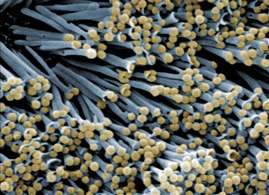| Nanotechnology | |||
Cork for nano tubes gives drug-delivery potential15 May 2006 Scientists at the University of Florida have found a way to “cork” nano tubes. The goal is a better way to deliver drugs, for example, for cancer treatment. Scientists want to find a way to fill the tubes with drugs and inject them into the body, where they will seek diseased or cancerous cells, uncork and spill their therapeutic contents in the right place.
“After making the nano test tubes, we saw the potential for them to be used for drug delivery vehicles, but because they are open at one end it would be like trying to ship wine in a bottle without a cork,” said University of Florida chemistry professor Charles Martin. “You have to cork it, which is what we have accomplished.” Martin is one of six University of Florida chemistry faculty members and graduate students who co-authored a paper about the research that appeared last month in the Journal of the American Chemical Society. While chemotherapy works against many cancers, it can cause severe side effects such as nausea, temporary hair loss and blood disease. To make the chemo hit only the cancerous cells, Martin and scientists elsewhere have spent recent years experimenting with drug-carrying nanotubes or nanoparticles. The approach makes sense for attacking diseased cells while bypassing healthy ones, but it also poses challenges. For one thing, the nanotubes must recognize their target, a problem scientists are attacking by tweaking their chemistry to make it respond to the unique chemistry of cancer cells. The tubes also must be biologically benign. Martin says a method for making nanotubes he pioneered, template synthesis, allows manufacturers to use biodegradable material, such as the polylactides used to make biodegradable sutures. Additionally, the tubes also had to be closed at one end to form the classic test tube shape, a problem Martin and his group solved in research published in 2004. To
cork the tubes in the latest research, the researchers applied an amino
chemical group to the mouth of the tubes and an aldehyde chemical group to
the corks. The two groups are complementary, so they bond with one another. The diameter of the tubes is about 80 nanometers, or 80-billionths of a meter. Even though they are tiny, each tube can hold about 5 million drug molecules. There is still one problem to solve to use the tubes for drug delivery, however. The Florida scientists still have to find a way to unlock the amino chemical group from the aldehyde chemical group to release the corks and the drugs at the desired site.
|
